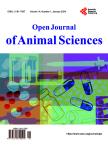Multilocus Sequence Typing of the Guangdong Isolates of <i>Riemerella anatipestifer</i>from Ducks in China
Multilocus Sequence Typing of the Guangdong Isolates of <i>Riemerella anatipestifer</i>from Ducks in China作者机构:Henry Fok College of Life Science Shaoguan University Shaoguan China Joint Laboratory of Animal Infectious Diseases Diagnostic Center Harbin Veterinary Research Institute CAAS-Shaoguan University Shaoguan China Department of Biology Science of College of Nature Science California State University San Bernardino USA College of Life Science and Foof Engineering Nanchang University Nanchang China
出 版 物:《Open Journal of Animal Sciences》 (动物科学期刊(英文))
年 卷 期:2015年第5卷第3期
页 面:332-342页
学科分类:1002[医学-临床医学] 100214[医学-肿瘤学] 10[医学]
主 题:MLST Remerella anatipestifer Phylogenetic Relationship Mutation Rate
摘 要:It is a very important significance to explore the bacterial typing methods rapidly, accurately and understand the genetic relation between isolates for controlling effectively the disease and preventing the dissemination and diffusion of the pathogen. The changes in the genetic material nucleotide sequences result in variation and evolution of bacteria, the development of molecular biology and genomics make typing of bacteria from phenotype to molecular typing. Riemerella anatipestifer is the causative agent of polyserositis of ducks and geese. We studied 54 isolates of Riemerella anatipestifer from Guangdong in China by multicolor sequence typing (MLST). The result showed that 54 isolates of Riemerella anatipestifer were divided into 14 STs, and among E3, b12xiao and Cb1 three isolates have with independent of type STs. It was found that there was high homology of RA and low genetic variability in the same area. The synonymous mutation and non synonymous mutation rate: dN/dS in seven housekeeping genes was lower than 0.25. Cluster analysis showed that the 54 isolates were clustered into 5 groups. eBRUST analysis showed that all isolates were clustered into one Group. It also proved that the genetic relationship was very closed in duck plague pathogen in this area;the source may be the same ancestors.



